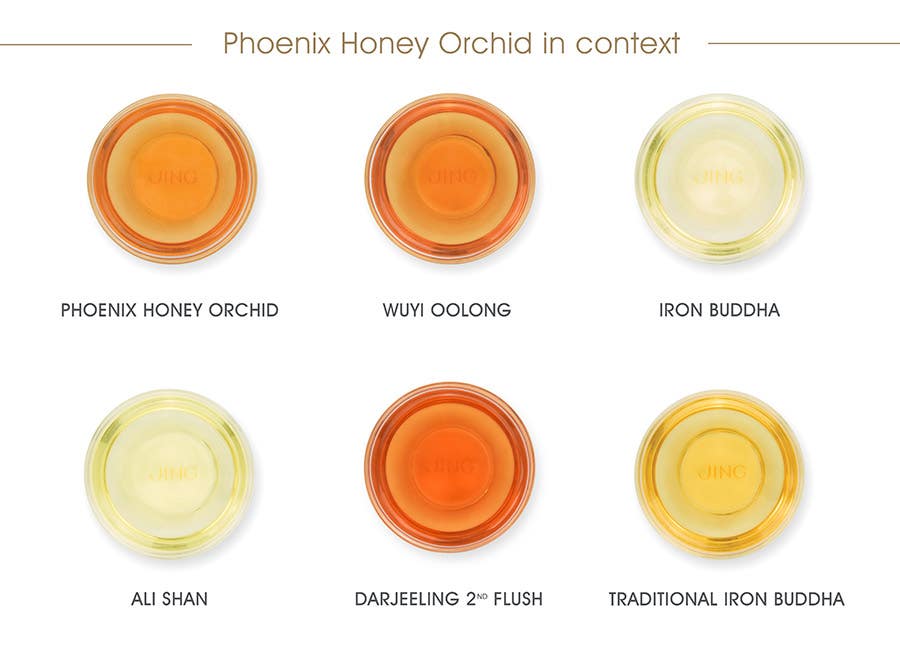Written by Felicity
How does it compare to five other teas?
At the start of this year, I was drinking a lot of Wuyi Oolong and black tea. As the weather warmed – and I was no longer commuting to the office – I began to have my first tea of the day sitting outside. I wanted something lighter and more refreshing than Wuyi, so I made our current batch of Phoenix Honey Orchid for the first time in a few months…
The aroma blew me away. It’s fruity and sharp, with complexity and interest – and it gives me good energy to start the day. It’s a big part of my routine for now, but that doesn’t mean it’s the right way to start the day for everyone.
Choosing different teas at different times of day (and changing them with the seasons) is one of the fulfilling things about tea drinking. Every tea has an essential character made up of: aroma and taste, body – does it feel thick or thin? Texture – does it feel very smooth in the mouth or is there a roughness to it? And finally, the feeling gives you – does it refresh you, comfort and warm you, or calm you and so on. Working out what you like in a tea using these essential characteristics – and when – can be a great guide as you explore the wide world of tea.
To help you work out if what’s good for me is also good for you, I’m using this piece to compare Phoenix to five other teas that share some of its essential characteristics, but are quite different to it in other ways. Hopefully you will then be able to decide which one is best for you…
What are the essential taste and characteristics of Phoenix Honey Orchid?
Phoenix Honey Orchid is a mid-dark oolong. Complex but accessible, it is light in body and has a structured texture that feels like honeycomb in the mouth. Phoenix is highly aromatic and leaves you feeling refreshed and energised but being a darker tea it is also warming. This sense of being both warming and refreshing is rare and one of the reasons that Phoenix is a very special tea.
Our flavour notes say: fruit, sweet, roasted and citrus – specifically, we’ve noticed Seville orange and orange blossom, fragrant peach, vanilla and honey. These high notes are prominent when you first infuse the leaves, which is why I’m calling this tea highly aromatic.
.

How does it compare to…
Wuyi Oolong
Wuyi is warmer and has more body than Phoenix. Both of these baked, dark oolongs are aromatic. In the Phoenix, the aromatics are concentrated in the high notes and there is a hint of sharpness to them, whereas in Wuyi there is still fruit but it’s as if it has been caramelised. There are also dark chocolate notes, meaning the aromatics are deeper and so bring a bigger sense of warmth.
This honeycomb structure in Phoenix is lighter than you’ll find in the more heavily baked Wuyi, where the rougher texture is complemented by a minerality – reminiscent of the rocky terrain it is grown in.
If you fancy a tea that’s thicker in body, with more warming comfort, Wuyi is for you. Phoenix will be lighter bodied and sharper.

Darjeeling Second Flush
This black tea is highly aromatic like Phoenix, but with a quite different flavour – some softer grape flavours rather than the sharp fruit in Phoenix. Darjeeling Second Flush also has some hay hops notes, so drier than the sweeter vanilla and honey found in Phoenix. But the essential difference is that, while Phoenix has some refreshment, Darjeeling Second Flush – as a black tea – is more warming. So, if you are looking for something aromatic and comforting, go for Darjeeling. Prefer something more energising? Phoenix is one to try.
Ali Shan
Ali Shan is very different to Phoenix. It is a light-bodied green oolong with tropical fruit and floral aromatics, known for its buttery texture and creamy milk flavour. Where the structure of Phoenix (that honeycomb texture again) gives bite to it, Ali Shan – with its smooth, creamy texture – is moistening and quenching. Both are refreshing. Choose Ali Shan if you want something green-ish in its refreshment and that’s thick and creamy. Choose Phoenix if you prefer something that’s darker, with the refreshment coming more from the sharper texture.

Iron Buddha
Iron Buddha is not so similar to Phoenix either. Its aromatics are on the green side and, like Ali Shan, Iron Buddha is a light-bodied green oolong. It has more structure in the texture than Ali Shan, but still not to the extent of the (now famous!) honeycomb structure of Phoenix. Iron Buddha will satisfy those who want the floral and summer fruit aromatics of a green oolong and the soft creaminess, but with a slight minerality beginning to show in the structure. Phoenix is for those who might prefer more structure, something a bit darker and the higher or sharper aromatics of Seville orange and citrus.
Traditional Iron Buddha
Similar in strength, Phoenix and Traditional Iron Buddha are moderately baked or roasted oolongs. The process gives them both a structured texture. The baking of Traditional Iron Buddha’s leaves brings out a warming, comforting character, and nutty flavours reminiscent of roasted hazelnuts. The fruit in Traditional Iron Buddha is autumnal and comforting, in contrast to the refreshing character of the Phoenix. Go for Traditional Iron Buddha if it’s the comfort you want from a thick-bodied tea with roasted warmth and fruit flavours. Phoenix is for when you’re looking for some refreshment, or you prefer a sharper fruitiness.



